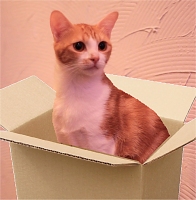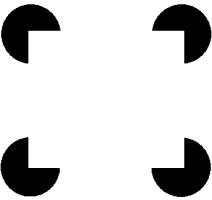The Cat in the Box

Many cats love boxes, so celebrations such as Christmas are always a treat for them. Most people with cats have noticed that their pets are often less fascinated with new toys than with the boxes that the toys came in - and the larger the box the better. It's not hard to figure out the connection between cats and boxes. Cats want to know whatís in the box (the link between cats and curiosity is proverbial), and if there is nothing there, they immediately put themselves there. After all, a box has four walls and it's a secure sitting place, so the cat wants to establish that this new addition to the household belongs - naturally - to the cat.
So cats like boxes. But how low do the sides of a box have to be before the cat won't sit there? How about a square on the ground? What about if there only seems to be a square on the ground?
This was the question tackled by Gabriella Smith, from the Department of Psychology in Hunter College, City University of New York, who studies animal behavior. She recently published the results of an investigation entitled 'If I fits I sits'.
In this investigation of our feline friends Ms Smith used the fondness of cats for sitting in boxes to understand their visual perception. Humans often fall for visual illusions where different shapes trick the mind into making false assumptions. So the question was whether cats recognise illusory contours - in this case, by sitting in a box that isn't there. Or to put it another way, will cats fall for the Kanizsa square visual illusion?

The Kaniza square was invented by the eponymous Gaetano Kanizsa, an Italian psychologist and artist who was interested in subjective contours. That is, images that visually evoke in the brain the idea of a line or edge that isn't really there. The Kanizsa square is created by four objects shaped like Pac-Man, oriented with the "mouth" facing inward to form the four corners of a square.
Think of four pies, each with one quarter cut away and then the pies aligned so that the missing quarters form the shape of a square. As we move the pies apart we continue to see the shape of a square in the middle. This 'square' has corners but no edges - however our brains add the edges automatically.
The question is, do cats also see these imaginary edges and react to them by sitting in the square that isn't there? Smith and her colleagues decided to test this. They had to enlist not just cats but also their humans because the best way to study this behavior was while the cats were relaxed and acting naturally in a home environment. The job of the humans was to simply print different figures (random shapes, an actual square, and the Kaniza illusion), put them on the floor and record if their cats entered and sat in the illusory square for at least 3 seconds.
The problem with this experiment was that which has bedeviled all cat researchers everywhere. Cats are ornery creatures that just won't do what they are supposed to. (This experiment was also carried out on dogs which were a lot more co-operative.) Originally 500 cats were enlisted, but the full experiment was only completed by thirty of them. Of those, nine cats selected at least one stimulus by sitting within a square (illusory or otherwise) with all limbs for at least three seconds.
Although the number of cats who showed a positive response was small, Smith showed that cats sat in the Kanizsa illusion just as often as they sat in the square and sat in both more often than in the control non-square pattern. So it appears that at least some domestic cats see the invisible Kanizsa contours as a cardboard square. This first-of-a-kind study provides insights into catís visual perception. "It's the presence of the contours, either in the Kanizsa square or in the real square, that causes cats to sit inside" Smith commented, noting that the cats preferred to sit in the 'square' between the 'Pac-man' shapes rather than on the shapes themselves.
So what's next for the researchers? Well they want to enlarge on this study by engaging more cats and probably bringing the experiments to the lab. The downside is that the researchers will be putting the cats into a somewhat unfamiliar environment, but on the plus side the behavioral studies can be done in a more controlled setting.
Reference
Gabriella E.Smith, Philippe A.Chouinard and Sarah-Elizabeth Byosiere. If I fits I sits: A citizen science investigation into illusory contour susceptibility in domestic cats (Felis silvestris catus). Applied Animal Behaviour Science (2021) vol 240. https://doi.org/10.1016/j.applanim.2021.105338
